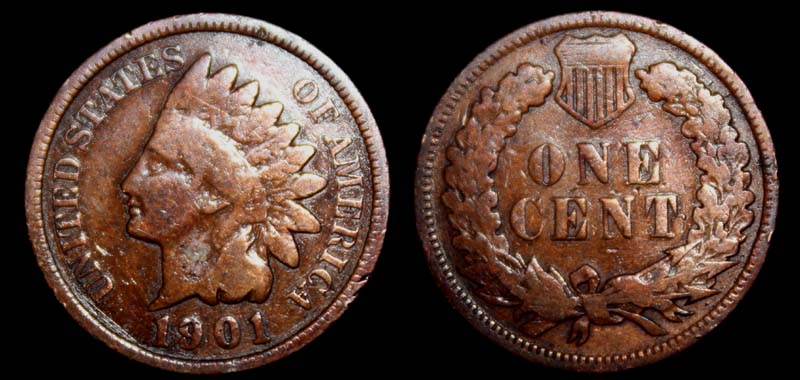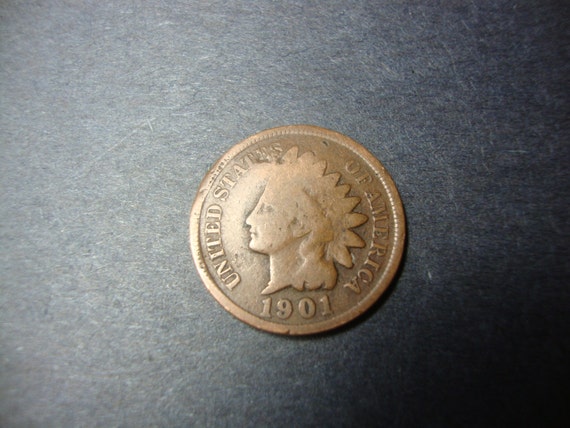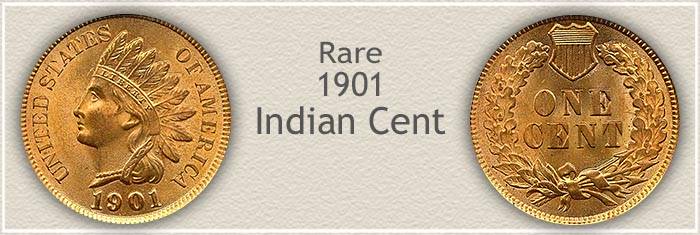1901 Indian Head Penny
- Indian Head Pennies
Indian Head pennies followed in the early success of the first small cents, which bore the Flying Eagle design minted from 1856 through 1858. Like the earlier series, Indian Head pennies were designed by James B. Longacre, who served as Chief Engraver of the United States Mint. Longacre served as chief engraver from 1844 until his death in 1869. Among Longacre’s other coin designs is the Shield nickel and the two cent piece, the latter of which in 1864 became the first U.S. coin to bear the motto IN GOD WE TRUST.
1901 Indian Head Penny

Heritage Auction Galleries. In 1859, when Indian Head cents were first made, they were composed of 88 percent copper and 12 percent nickel. In 1864, the U.S. Mint stopped using nickel in the production of Indian Head pennies and changed to a bronze composition, consisting of 95 percent copper and 5 percent tin and zinc. The Indian Head Cent was produced from 1859 to 1909, following the very short lived Flying Eagle Cent series. During the Indian Head Cent’s run, coins were produced primarily at the Philadelphia Mint, with the final two years also produced at the San Francisco Mint. The series includes a change of the reverse design following. 1901 Indian Head Penny CoinTrackers.com Coin Values Online Type: Indian Head Penny Year: 1901 Mint Mark: No mint mark Value: As a rough estimate of this coins value you can assume this coin in average condition will be valued at somewhere around $2.50, while one in mint state (MS) condition could bring $60 at auction if certified.
Longacre’s famous Indian Head penny is thought by some to bear the portrait of a specific member of a Native American tribe. In fact, the young woman on the coin is a portrayal of Miss Liberty and bears many Caucasian features. It has long been thought that the design was modeled after Longacre’s daughter, Sarah, who visited her father at the U.S. Mint one day when several Native Americans were in attendance there.

The story goes that a Native American chief placed his traditional headdress on the young girl’s head. Her artist father quickly sketched the image to show to his wife (in an era before photography was widely used), and it was from this sketch that the Indian Head penny design is said to have derived. Other accounts suggest that a statue of Venus exhibited in Philadelphia while on loan from the Vatican may have also been an inspiration for Longacre’s design work on the Indian Head penny.
Whatever the design inspiration for the coin may be, the Indian Head penny is one of the most popular and widely collected U.S. coins from the 19th century. This is so for several reasons. For one, it’s a largely affordable coin with only a few expensive, rare key dates (namely the 1877 and 1909-S counted among those pricier coins); and Indian Head pennies, especially those made since the 1880s, are readily available in the collector market. Also, the series was struck on an annual basis for some 50 years, meaning there are plenty of different issues for the coin collector to pursue.
Though they haven’t been made since 1909, Indian Head pennies are still widely recognizable and are pursued by collectors of all ages, including children. While some people only want a few examples of Indian Head pennies to keep as type pieces or memorabilia, these coins are still largely collected as an entire series. There are plenty of coin folders and coin albums to this day that accommodate an entire collection of Indian Head pennies. Often, Indian Head pennies are collected along with Flying Eagle pennies.
Latest Blog Posts
1901 Indian Head Penny Ebay

